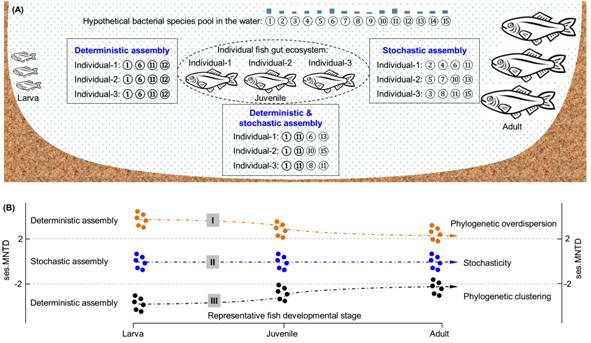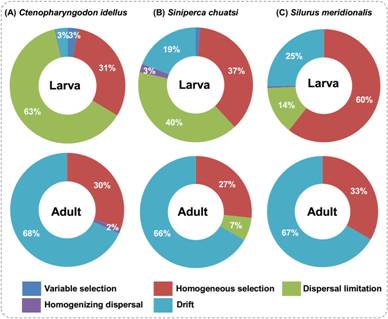
Newsroom
Environmental Filtering Governs Assembly of Fish Gut Microbiota
How environmental microbes colonize the fish gut ‘island’ ecosystem, and which ecological processes drive the microbial community assembly remains unknown. Dr. Yan Qingyun and his colleagues from Institute of Hydrobiology, Chinese Academy of Sciences revealed that environmental filtering is the major process governing the fish gut microbiota, but its contribution to the community assembly decreases with host development. This study not only expands our understanding of the fish gut micro-ecosystem, but also can contribute further insights to community assembly studies in mammalian gut ecosystems.
To understand the community assembly in fish gut ecosystem, three major aquaculture fish species in China (i.e., herbivorous Ctenopharyngodon idellus, carnivorous Siniperca chuatsi, and Silurus meridionalis) were studied from the larval stage to the adult stage. The high-throughput sequencing was used to assess the taxonomic compositions and phylogenetic diversity of gut microbiota across host development. The major ecological processes and their contributions to the microbial community assembly and turnover were then determined by null model test, phylogenetic-based mean nearest taxon distance (MNTD), and βMNTD in combination of Bray-Curtis-based Raup-Crick (RCbray) distance analyses.
Results indicate that taxonomic diversity of gut microbiota in the three examined freshwater fish species showed clear stage-specific patterns. Further phylogenetic analyses suggest that host gut environmental filtering led to the assembly of microbial communities in the fish gut ‘island’ ecosystem. However, the phylogenetic clustering of local communities and deterministic processes driving community turnover became less distinct as the fish developed. The relative importance of ecological processes that govern the community turnover of gut microbiota also found to be different in larva and adult. In brief, determinism (selection and dispersal) levels in the larvae (especially in the carnivorous S. chuatsi and S. meridionalis) were stronger than those found in the adults, whereas stochasticity (drift) levels significantly increased in the adults.
This study was mainly performed with the cooperation of the research groups led by Prof. YU Yuhe and Prof. WANG Yaping at Institute of Hydrobiology, Chinese Academy of Sciences, and Prof. ZHOU Jizhong at Institute for Environmental Genomics, University of Oklahoma.
This work was published online in Environmental Microbiology as an original article entitled “Environmental filtering decreases with fish development for the assembly of gut microbiota”. It was funded by the National Natural Science Foundation of China, and the Youth Innovation Promotion Association of the Chinese Academy of Sciences.
 |
| Figure 1. Schematic representation of how ecological processes govern the assembly of a local community in the fish gut ecosystem(Yan et al., 2016). |
 |
| Figure 2. Contribution of ecological processes that determines the microbial community turnover in the fish gut ecosystem (Yan et al., 2016). |
Contact:
Dr. YAN Qingyun
Institute of Hydrobiology, Chinese Academy of Sciences
Tel: +86-27-68780678
E-mail: yanqyun@ihb.ac.cn